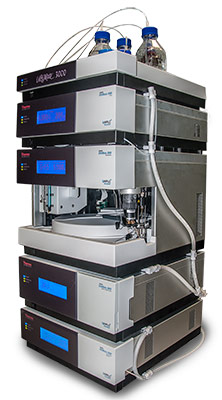
| OELCHECK test instrument: | HPLC System UltiMate 3000 Thermo Fisher Scientific |
| Sample quantity: | 15 mL |
| Unit: | % (relative to fresh oil) |
| Test result: | content of tolyltriazole and possibly other non-ferrous metal inhibitors |
| Analysis for: | gear oils |
| Brief description: | The gear oil is diluted in pentane. The non-ferrous metal inhibitors are separated from the matrix by solid phase extraction and then eluted in a mixture of water and acetonitrile. Two microliters of the extract are transferred to a chromatographic separation column using a mobile phase. Due to interactions, the analytes remain on the stationary phase of the column for different lengths of time. This separates the sample into the individual analytes. The analytes elute gradually and are registered after separation at a characteristic retention time by means of a UV/VIS detector. The most common non-ferrous metal inhibitor is tolyltriazole. In addition, benzotriazole and mercaptobenzothiazole can also be detected. |
| Statement: | The inhibitors protect the surfaces of non-ferrous metals, e.g. copper, from wear and corrosion by forming a stable protective layer of coordination compounds. However, since this protective layer is also subjected to wear, it is permanently regenerated from the inhibitor in the oil. If the residual content of inhibitors in the oil has clearly decreased, no further regeneration can take place. As a result, there is a risk of wear or corrosion on the non-ferrous metal surfaces. |
| Underlying test standard: | OELCHECK test method OPM 115 |